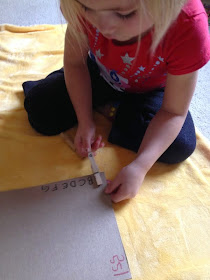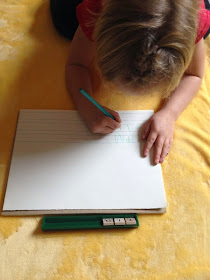I had a friend who recently moved away ask for some ideas on working with her son at home to make things a little more interesting while practicing numbers and letters. This will be a rather dry post, but hopefully useful to anyone who can't send their child to preschool, perhaps prefers to have them learn exclusively at home, or even to supplement classroom learning. There are not a lot of supplies needed and if you don't have them on hand, they can easily and cheaply be purchased at the dollar store, thrift store (I get many games at thrift stores just for the pieces) or even made by cutting up colored cardstock (for more fun and variety) and using a marker to write on them. When I say "you" below it will refer to the child.
These are just simple paper circles with numbers on them. Place them in order, say the name of each as placing and/or name (count) them once all laid out. Mix them up and point to a number and name it.
Using the same number set and adding another (this is just from our Rummikub game). This is just basic number matching. As with above, you can name them as you place them.
Using a number set, place counters by each number equal to the number value. To make things more fun, using a variety of items for counters will help, or even mix and match. I know you can get these glass gems at the dollar store. To make a full 1-10 set you will need 55 pieces (210 for 1-20). Other items you can try are beans, coins, paper clips, mini erasers (the $1 spot at Target has 60 piece sets right now that would work great), basically anything that can be counted.
Using a little bag, box, or anything that will hide the number set, draw out a number and then place that number of counters by it. This will help in actual counting vs. just knowing there is one more than the last as in the game above.
Also using the bag, pull out a number at random and practice writing it. You could even pull out 2 numbers - one representing which number to practice, the other representing how many time you have to write it down.
The same game can be played with a die or dice. (You can buy a 10 pack at the dollar store or dig one out of a game already in your closet). This version will help them to count and then reflect on which written number represents it before writing it from memory.
Another game can be played using a set of dominoes (I got this mini set at the dollar store) and a pair of dice. Pull a domino out and then find the face on each die that matches. Say how many dots are on each die.
Pull out a domino and place counters next to them, matching the number of dots with the counters.
The domino set can also be used to match to the number sets.
You can also do some basic math with the dominoes. Pull a domino out, count the number of dots and place the total number below domino.
Same two games with a single die or dice. Match dots to number.
Add another row with the sum of the 2 numbers.
Similar to above, but with different pieces. Roll the die, place matching number of counters below.
This one is good for matching and fine motor skills. The cardboard is just an old cereal box. I wrote the numbers here, but a child could easily do that part first. Just write some numbers on the clothespins (again, purchased from the dollar store) and then match to numbers on the cardboard. For an added level of difficulty, try this with the number matching to the number word. This is good practice for sight words.
Switching over to letters. Write a capital letter on one side of the clothespin and lower case on the other. Match capital letter clothespin to lower case letter on cardboard.
Lower case matching.
Lower case clipping to capital.
And capital to capital.
For an added challenge put letters in a random order (the same can be done with the numbers).
For this activity use a game like Scrabble, Upwords, etc. or just cards with handwritten letters. Like above, place a full set of 26 in a bag or hat and pull one out, say what it is, what it sounds like and/or write it down. Repeat for the entire alphabet if possible.
Same as previous activity, but write the lowercase version of the letter.
For this one I just pulled out a few letters that made a real word. You (the parent this time :) )could have a list of names or places that your child is familiar with in addition to simple CVC words and sight words. Those could be drawn out of a bag as well.
Drawing out letter tiles, practice writing letter in salt (or corn meal, shaving cream, finger paint, etc). By changing the substance the writing is done in, this activity can be a great sensory experience as well as just making it not be boring after a few times. For an additional sensory experience, add a little bit of spice to the salt (cinnamon, cloves, ginger, garlic power, etc.).
The "erasing" part is fun. It just takes a gentle side to side swish. Ideas for trays: cheap ones at dollar store, this one is a lid from a candy tin, cookie sheet, clean/unused meat tray from the grocery store, lid of a shoebox.
The activity can be done using a writing instrument too. Try the back side of a pencil, a craft stick, a stick from outside, a princess wand, and the ideas go on.
Draw a letter out and recreate with counters.
This would be great to do with a white board. One way is for an adult to just write a letter and the child covers it with counters. The letter can be picked at random or drawn from a bag/hat. Another way is for the child to pull a letter out, then write it themselves and then cover it with counters.
This is just a basic alphabet I typed up on Excel, it can be quickly just written on a piece of paper too. I'd recommend a lower case version as well. Draw a number from the bag and match it. Pretty simple. Similar to the clothes pin version of this, a paper with the alphabet jumbled up would help increase the difficulty. Again, say the name of the letter and the sound it makes as much as needed while playing these. Maybe even add in a word that starts with that letter.
Because I don't have a lower case chart, but do have a set of lower case letters, we used our counters like a Bingo game, finding the capital version of the letter.
This is another sensory activity that most kids seems to enjoy. It's a letter hunt. Mini sensory bins to not have to be elaborate. This is just a large-ish Ziploc disposable container. I like getting the fill from bulk bins at the grocery store. Beans, rice, lentils, shredded paper, even shaving cream are fun fillers.
Last one for now. Letter sort. This is one where I'd recommend having a few different colors and fonts, both upper and lower case letters. Start with just 3 letters (but 5 or so of each of them - like 5 Ls, 5 Qs and 5 Hs or something like that) to sort. To increase difficulty, use more letters at once (either number of or letters) or use letters that have similar features.



































Glad I'm stumbled upon to this blog, the content is very information thanks for sharing such piece of knowledge with us. feel free to
ReplyDeleteHow to Improve Body Posture
Good Article you know your article it's useful me. it's really good and helping your article and yes thanks for sharing information
ReplyDeleteFor sofa repair work contact thesofastore gives
Sofa Refurbishing in Kanakapura
Your blog is very informative for us.
ReplyDeleteclick the below links
Best Astrologer in Raichur
Very useful blog thanks for sharing.
ReplyDeleteTo learn Web Design Courses in Mysore.Contact us.
Very good article,Thank you
ReplyDeleteFor sofa renovation contact thesofastore they gives best
Sofa Refurbishing in Kundalahalli,Bangalore
Nice post. Keep sharing. Thanks for sharing.
ReplyDeleteabhiram astrology center. Best Astrologer In malleswaram
Nice and useful blog.
ReplyDeleteFor Airport Taxi Bangalore. Contact us.
Nice post.
ReplyDeleteVisit Best indian Astrologer in White Rock.